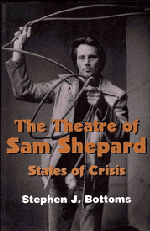Introduction
States of Crisis
Published online by Cambridge University Press: 01 June 2011
Summary
When sam shepard's one-act playStates of Shock premiered in New York in 1991, the title, if not the piece itself, seemed almost to summarize the author's entire output. The phrase, which recurs elsewhere in his work, is an apt description for the arresting, disturbing atmospheres which Shepard's plays so often create onstage. While the subtitle of this book expands the frame of reference somewhat (“shock” being only one of the forms of disorientation experienced by the plays' characters and, indeed, by their audiences), this is nevertheless its starting point. The tensions and contradictions generated by Shepard's writing – whether overt or, in much of his later work, more covert – tend to disrupt any possibility of the theatrical event's being experienced smoothly, and so throw up all kinds of unresolved questions. Although Shepard's work has gone through many phases since he first began writing for Off-Off-Broadway venues in 1964, this instability has been a distinguishing feature throughout.
One way to begin to look at Shepard's theatre is to contrast his approach with that of another major American dramatist of recent years, David Mamet. The two share certain superficial similarities in their concerns which have led to frequent comparisons, but there is a fundamental difference in their approaches.
- Type
- Chapter
- Information
- The Theatre of Sam ShepardStates of Crisis, pp. 1 - 22Publisher: Cambridge University PressPrint publication year: 1998



